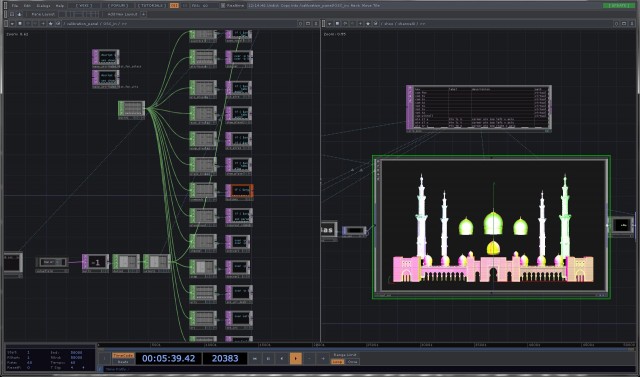Sheikh Zayed Grand Mosque Projections from Obscura Digital on Vimeo.
Illuminating the facades of United Arab Emirates mosque and historical architecture with extraordinary imagery, Obscura Digital transformed these structures with visuals both decorative and cultural. It’s a visually-rich celebration of Arabic and Emirati culture, and one of the developers – absurdly-prolific artist and geek virtuoso Barry Threw – walks us through some of the details of how it was produced, all using TouchDesigner software.
The mosque, top:
In celebration of UAE National Day 2011
Projection and design by Obscura Digital44 projectors with a combined brightness of 840,000 lumens
were used to cover a surface 600ft wide x 351ft high
Barry explains in detail how this lavish projection project came into being – and get ready for some nerdy vocabulary, folks, which is part of why we love what we do:
All of the mapping is done with TouchDesigner.
The first step in the pipeline is getting some sort of model of the structure involved. In this instance, we used a laser scanner to output a 3d point cloud of the building. This point cloud then needs to be turned into a mesh, and then we re-topologize it into a simpler mesh that can be easily handled in realtime. There is a high degree of skill necessary in this process.
At the same time, the physical projector locations have to be decided upon. This depends upon the actual map of the building and surrounding area, where we can get access to, and what kind of structures we are allowed to build. This particular job was easy in terms of obstructions of the surrounding area, but difficult because of the sacred nature of the site. All of our projector towers had to be well designed with facades to match the mosque architecture.
The projector placement and physical production aspects are a behemoth tasks in themselves. Number and placement of projectors has many variables, but in general, maximum brightness, full area coverage and optimal resolution are the major ones.
The art design process is another concurrent pipeline. After the 3d model and general projector spec’ing is complete, a template can be made to render the content, which has previously been put through an extensive creative process. This is output as video, in our case using a currently-proprietary codec called FireFrame, which are then textured onto the 3d model.
Projector calibration is basically a two-step process.
We typically use stacks of projectors to achieve higher lumens over the projected area. So the first stage is converging stacks of projectors to make a single, clear image.
Secondly, physical projector extrinsics must be calculated to match a virtual camera in our 3D world. We are currently using a technique that I’m lovingly referring to as “Sain-O’Neill Extrinsic Trilateration,” or SONET. Basically, it involves triangulating the projector and projection centroid placements based on other known onsite architectural features.
This gets you fairly close with careful application, but a number of post-3D and 2D transformations are used on the geometry to account for the fallible nature of the physical world to which we are chained. There is also a separate group of procedures that are used in the instances where a blend between two channels are necessary, and the one that we use is dependent on the architecture.
Equipment used / number and types of projectors / lumens / power:
44 projectors on the mosque (24 x 20K lumens + 20 18K lumens) = 840,000 lumens
5 projectors on the fort (5 x 20K lumens) = 100,000 lumens
940,000 lumens total
49 projectors x 3.2kW x 60 hours = 9,400kW total show (Mosque and Fort)CO2 Offsetting plan:
9,400kW = 12,878 lbs of CO2 = 6 tons of CO2
(1.37 pounds CO2 per kW / 2204 pounds = 1 ton of CO2)
6 tons x 5 trees per ton = 30 trees
Equipment rigs:
Custom-built projector enclosures based on floral designs that match the mosqueArchitectural mapping / scanning components:
Obscura laser scanned the surface area of the mosque to generate 3D models.
Incredibly complex geometry: flat walls with intricate hand carved details (all mapped); arcades with rows of columns; domes ranging in size from the “small” 7m ones on the sides of the main gate to the 37 and 46m main domes of the prayer hall; all four of the 107m minarets.I’d like to mention Dorian Orange (http://www.dorianorange.com/), a NY based shop who helped us immeasurably with the media on this project.
More information:
http://obscuradigital.com/
http://www.derivative.ca/ [developers of TouchDesigner]
UAE National Day Grand Mosque Architectural Projection Mapping [barry threw blog]
UAE National Day Fort Al Jahili Architectural Projection Mapping [barry threw blog]
A massive team worked on the project. Credits:
Technical Direction
Andrew Plourde
Eugene Dowlen
Simon Ransom (theRansoms)
Creative Direction / Media
Travis Threlkel
Marta Salas Porras
Ron Robinson
Nathaniel Ruhlman (Dorian Orange)
Production
Gaston Albanell
Nick Lynch
Diego Novoa
Rainen Janes
Joe Vigorito
Nathan Houchin
Eric Knuble
Interactive Development
Mary Franck
Grady Sain
Imran Nabhan
IT
Sean Holt
Photos / Documentation
Josh Brott
Block IPDelete


